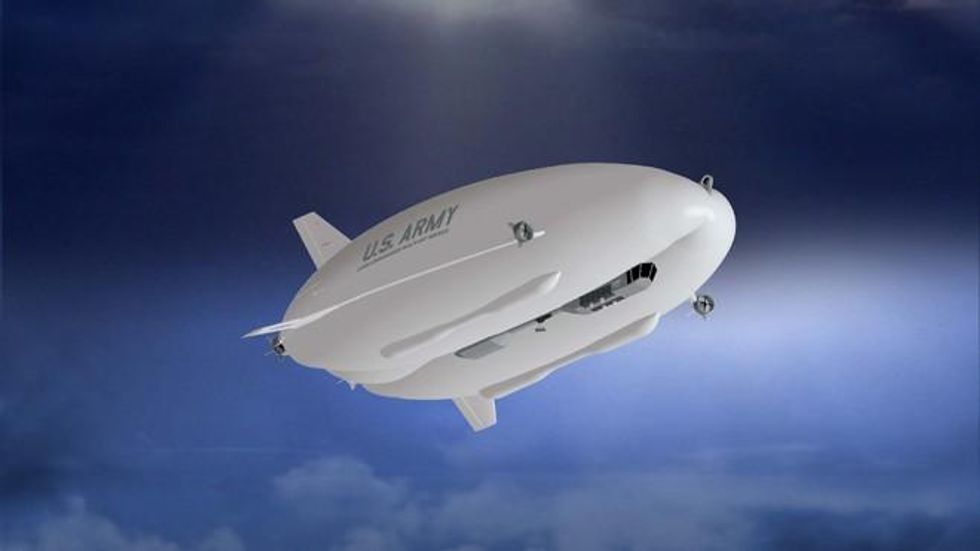Latest US Army 'Spy Blimp' to Offer 'Unblinking' Surveillance for Weeks on End
Newest drone tested for US battlefields abroad as older drones prepped for domestic deployments

The US Army recently field tested their latest surveillance drone over the skies of New Jersey.
This latest drone, however--built by Northrup Grumman--will not easily be mistaken for the well-known and sleekly designed Predator or Reaper drones currently deployed around the world by the US military. As tall as a seven-story building and almost as long as a football field, the Army's "Spy Blimp" looks more like a giant flattened marshmallow than a $172 million military "hybrid aircraft."
Not yet deployed by the military, the so-called "Long Endurance Multi-Intelligence Vehicle" (LEMV) spent over an hour hovering around Joint Base McGuire-Dix-Lakehurst last week, demonstrating its ability to take off and land during its first major publicly viewed test flight. The military is contracted to pay $517 million for three LEMV's built by the arms manufacturer.
According to Network World, the test flight "included two pilots, but the Army intends for the LEMV to be like the Predator, an unmanned flying surveillance machine." The ship is designed to move at a slower pace than its smaller drone forbears, moving at speeds between 30 and 80 knots, but both Northrup Grumman and the Army lavished praise on the blimp's ability to offer an "unblinking" watchful eye over its area of surveillance for as many as three weeks without refueling.
Previously the Army News Service reported, "The array of payloads include Combined with an array of payloads - including ground moving target indicator radar, Electro Optical/Infra-Red sensors, communications relay, blue force tracking, signal intelligence, and electronic counter measures - the LEMV will augment existing ISR platforms to provide additional capabilities."
Video of the test flight:
"If all goes smoothly," according to a fawning Fox News report, the LEMV "is set to enter live trials in Afghanistan in 2013."
In related news, surveillance blimps already deployed in Afghanistan, according to the Wall Street Journal on Tuesday, are being prepared for domestic deployment over the US/Mexico border.
According to the Journal:
Over the next few weeks, the military will oversee a test in south Texas to determine if a 72-foot-long, unmanned surveillance blimp--sometimes called "the floating eye" when used to spot insurgents in Afghanistan--can help find drug runners and people trying to cross illegally into the U.S.
The project is part of a broader attempt by U.S. officials to establish a high-tech surveillance network along the border and find alternative uses for expensive military hardware that will be coming back from Afghanistan, along with the troops.
In addition to the blimps, border officials are exploring more than 100 other types of military gear, from hand-held instant-translation devices that could be used at crossings to sensors that can monitor up to a 10-mile diameter area for days at a time.

An Urgent Message From Our Co-Founder
Dear Common Dreams reader, The U.S. is on a fast track to authoritarianism like nothing I've ever seen. Meanwhile, corporate news outlets are utterly capitulating to Trump, twisting their coverage to avoid drawing his ire while lining up to stuff cash in his pockets. That's why I believe that Common Dreams is doing the best and most consequential reporting that we've ever done. Our small but mighty team is a progressive reporting powerhouse, covering the news every day that the corporate media never will. Our mission has always been simple: To inform. To inspire. And to ignite change for the common good. Now here's the key piece that I want all our readers to understand: None of this would be possible without your financial support. That's not just some fundraising cliche. It's the absolute and literal truth. We don't accept corporate advertising and never will. We don't have a paywall because we don't think people should be blocked from critical news based on their ability to pay. Everything we do is funded by the donations of readers like you. Will you donate now to help power the nonprofit, independent reporting of Common Dreams? Thank you for being a vital member of our community. Together, we can keep independent journalism alive when it’s needed most. - Craig Brown, Co-founder |

The US Army recently field tested their latest surveillance drone over the skies of New Jersey.
This latest drone, however--built by Northrup Grumman--will not easily be mistaken for the well-known and sleekly designed Predator or Reaper drones currently deployed around the world by the US military. As tall as a seven-story building and almost as long as a football field, the Army's "Spy Blimp" looks more like a giant flattened marshmallow than a $172 million military "hybrid aircraft."
Not yet deployed by the military, the so-called "Long Endurance Multi-Intelligence Vehicle" (LEMV) spent over an hour hovering around Joint Base McGuire-Dix-Lakehurst last week, demonstrating its ability to take off and land during its first major publicly viewed test flight. The military is contracted to pay $517 million for three LEMV's built by the arms manufacturer.
According to Network World, the test flight "included two pilots, but the Army intends for the LEMV to be like the Predator, an unmanned flying surveillance machine." The ship is designed to move at a slower pace than its smaller drone forbears, moving at speeds between 30 and 80 knots, but both Northrup Grumman and the Army lavished praise on the blimp's ability to offer an "unblinking" watchful eye over its area of surveillance for as many as three weeks without refueling.
Previously the Army News Service reported, "The array of payloads include Combined with an array of payloads - including ground moving target indicator radar, Electro Optical/Infra-Red sensors, communications relay, blue force tracking, signal intelligence, and electronic counter measures - the LEMV will augment existing ISR platforms to provide additional capabilities."
Video of the test flight:
"If all goes smoothly," according to a fawning Fox News report, the LEMV "is set to enter live trials in Afghanistan in 2013."
In related news, surveillance blimps already deployed in Afghanistan, according to the Wall Street Journal on Tuesday, are being prepared for domestic deployment over the US/Mexico border.
According to the Journal:
Over the next few weeks, the military will oversee a test in south Texas to determine if a 72-foot-long, unmanned surveillance blimp--sometimes called "the floating eye" when used to spot insurgents in Afghanistan--can help find drug runners and people trying to cross illegally into the U.S.
The project is part of a broader attempt by U.S. officials to establish a high-tech surveillance network along the border and find alternative uses for expensive military hardware that will be coming back from Afghanistan, along with the troops.
In addition to the blimps, border officials are exploring more than 100 other types of military gear, from hand-held instant-translation devices that could be used at crossings to sensors that can monitor up to a 10-mile diameter area for days at a time.


The US Army recently field tested their latest surveillance drone over the skies of New Jersey.
This latest drone, however--built by Northrup Grumman--will not easily be mistaken for the well-known and sleekly designed Predator or Reaper drones currently deployed around the world by the US military. As tall as a seven-story building and almost as long as a football field, the Army's "Spy Blimp" looks more like a giant flattened marshmallow than a $172 million military "hybrid aircraft."
Not yet deployed by the military, the so-called "Long Endurance Multi-Intelligence Vehicle" (LEMV) spent over an hour hovering around Joint Base McGuire-Dix-Lakehurst last week, demonstrating its ability to take off and land during its first major publicly viewed test flight. The military is contracted to pay $517 million for three LEMV's built by the arms manufacturer.
According to Network World, the test flight "included two pilots, but the Army intends for the LEMV to be like the Predator, an unmanned flying surveillance machine." The ship is designed to move at a slower pace than its smaller drone forbears, moving at speeds between 30 and 80 knots, but both Northrup Grumman and the Army lavished praise on the blimp's ability to offer an "unblinking" watchful eye over its area of surveillance for as many as three weeks without refueling.
Previously the Army News Service reported, "The array of payloads include Combined with an array of payloads - including ground moving target indicator radar, Electro Optical/Infra-Red sensors, communications relay, blue force tracking, signal intelligence, and electronic counter measures - the LEMV will augment existing ISR platforms to provide additional capabilities."
Video of the test flight:
"If all goes smoothly," according to a fawning Fox News report, the LEMV "is set to enter live trials in Afghanistan in 2013."
In related news, surveillance blimps already deployed in Afghanistan, according to the Wall Street Journal on Tuesday, are being prepared for domestic deployment over the US/Mexico border.
According to the Journal:
Over the next few weeks, the military will oversee a test in south Texas to determine if a 72-foot-long, unmanned surveillance blimp--sometimes called "the floating eye" when used to spot insurgents in Afghanistan--can help find drug runners and people trying to cross illegally into the U.S.
The project is part of a broader attempt by U.S. officials to establish a high-tech surveillance network along the border and find alternative uses for expensive military hardware that will be coming back from Afghanistan, along with the troops.
In addition to the blimps, border officials are exploring more than 100 other types of military gear, from hand-held instant-translation devices that could be used at crossings to sensors that can monitor up to a 10-mile diameter area for days at a time.


